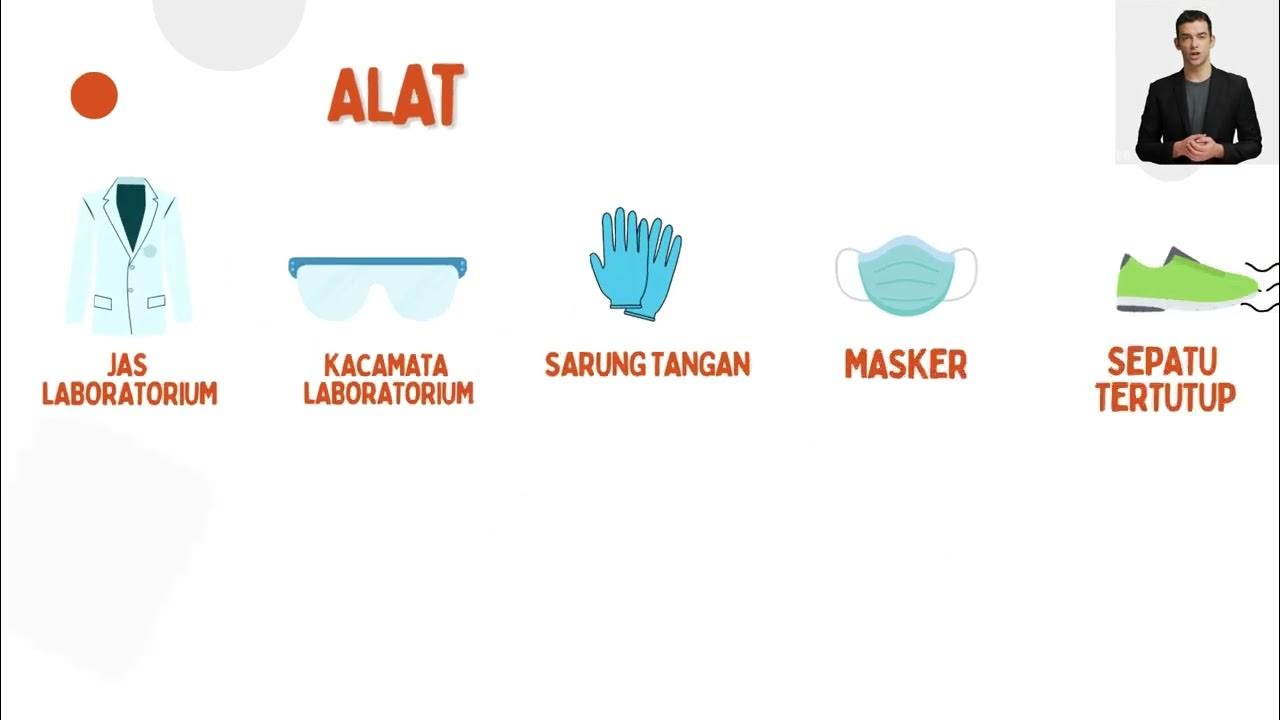Ayo kenalan dengan Laboratorium Kimia! Kimia SMA kelas 10 semester 1
Summary
TLDRThis video introduces viewers to the essentials of working in a chemical laboratory, focusing on symbols used to identify hazardous materials, common lab tools, and safety equipment. It covers various symbols such as those for poisonous, flammable, corrosive, and explosive substances, highlighting the importance of recognizing these warnings. The video also explains the purpose and usage of essential lab tools like test tubes, beakers, and burettes, as well as safety gear including laboratory coats, gloves, and face masks. The content aims to ensure proper understanding and safe practices in a chemistry lab environment.
Takeaways
- 😀 Safety symbols are essential in a chemical laboratory to warn about hazardous materials such as poisons, flammables, and corrosives.
- 😀 Poisonous materials are indicated by a symbol with a skull and crossbones, indicating the material can cause serious health issues or even death.
- 😀 Flammable substances are marked with a fire symbol, signaling that they are easily ignitable.
- 😀 Corrosive substances, marked by a hand and liquid symbol, can damage living tissue, requiring special care during handling.
- 😀 Irritating materials are marked with a symbol of a substance causing skin or respiratory system irritation, even in small amounts.
- 😀 Toxic materials have a skull and crossbones symbol, signifying they can cause serious illness or death even in tiny quantities.
- 😀 Oxidizing agents, indicated by a fire symbol, can produce heat when they react with other materials, especially flammable ones.
- 😀 Explosive materials are marked with an explosion symbol, warning that they may explode when exposed to heat, friction, or shock.
- 😀 Laboratory tools like test tubes, beakers, and Erlenmeyer flasks are used for various functions such as mixing, heating, and measuring substances.
- 😀 Personal protective equipment (PPE) like lab coats, gloves, and masks are necessary to ensure safety in the laboratory by preventing exposure to hazardous materials.
Q & A
What is the significance of chemical symbols in a laboratory setting?
-Chemical symbols in a laboratory are used to indicate potential hazards associated with materials. These symbols help laboratory workers identify dangerous substances and take necessary precautions to handle them safely.
What does the Poison symbol represent, and how should it be treated in the lab?
-The Poison symbol, often shown with a skull and crossbones, represents substances that are toxic. These materials should be handled with care, and exposure should be avoided to prevent harmful effects or even death.
How can you identify flammable materials in the lab?
-Flammable materials in the lab are marked with a symbol of fire or flame. These materials are highly sensitive to heat and can easily catch fire, so it's crucial to avoid open flames or heat sources around them.
What does the corrosive symbol indicate, and why is it important to follow safety measures for such materials?
-The corrosive symbol indicates that the material can damage living tissue and other substances. These materials can cause severe burns or permanent damage, so wearing proper protective gear, such as gloves and goggles, is essential.
What is the purpose of a test tube in a chemistry laboratory?
-A test tube is a basic tool used to hold, mix, or heat small amounts of chemicals during experiments. It is often used for conducting reactions or storing substances temporarily.
What distinguishes a measuring flask from a beaker or measuring cup?
-A measuring flask is designed for making solutions with precise concentrations. Unlike beakers and measuring cups, it provides a high level of accuracy and is typically used for diluting solutions or mixing chemicals in specific amounts.
Why should a burette be used during titration rather than other measuring tools?
-A burette is used during titration because it allows for the precise, controlled addition of a solution to another. This precision is essential in determining the exact point of the reaction, which is crucial in titrations.
What function does a mortar and pestle serve in the lab?
-A mortar and pestle are used to grind or crush solid substances into powders. This is often necessary when preparing substances for reactions or experiments.
Why is it necessary to wear gloves in the laboratory, and what types of substances do they protect against?
-Gloves are necessary to protect the hands from hazardous substances, such as chemicals, hot materials, or sharp objects. They prevent direct contact with dangerous or corrosive chemicals that could cause burns or other injuries.
How do laboratory coats contribute to safety in the chemical lab?
-Laboratory coats protect the skin and clothing from splashes, spills, and contamination by hazardous chemicals. They help reduce the risk of exposure to harmful substances and ensure that accidents do not directly harm the worker.
Outlines

This section is available to paid users only. Please upgrade to access this part.
Upgrade NowMindmap

This section is available to paid users only. Please upgrade to access this part.
Upgrade NowKeywords

This section is available to paid users only. Please upgrade to access this part.
Upgrade NowHighlights

This section is available to paid users only. Please upgrade to access this part.
Upgrade NowTranscripts

This section is available to paid users only. Please upgrade to access this part.
Upgrade NowBrowse More Related Video

KESELAMATAN DAN KEAMANAN KIMIA DI LABORATORIUM

Keselamatan Kerja di Laboratorium | Tata Tertib & Simbol Bahan - Sains

Keselamatan Kerja di Laboratorium IPA Mata Kuliah Pendalaman Materi IPA

Pengenalan Alat Laboratorium

Bab 1 Hakikat Ilmu Sains dan Metode Ilmiah #2 (Laboratorium IPA) | IPA SMP 7 | Sekolah Penggerak

SAINS Tingkatan 4 KSSM I BAB 1 I Langkah Keselamatan di dlm Makmal I 1.1 Peralatan Perlindungan Diri
5.0 / 5 (0 votes)